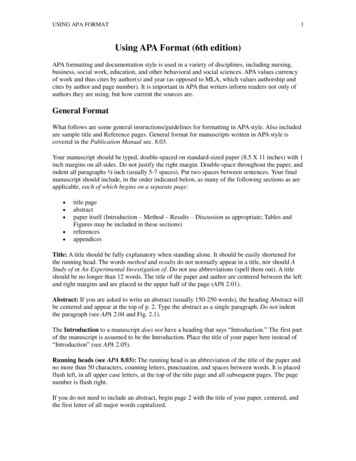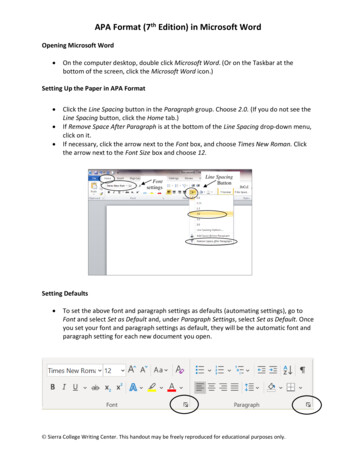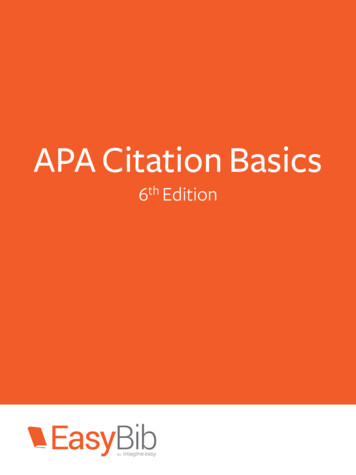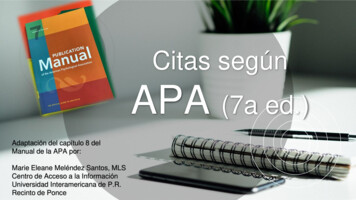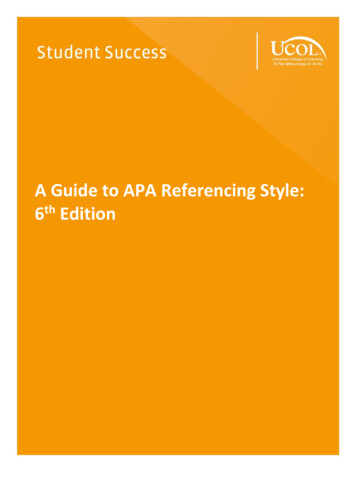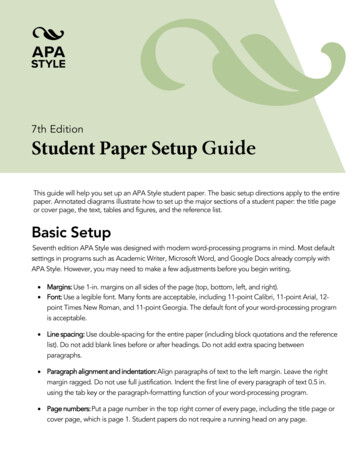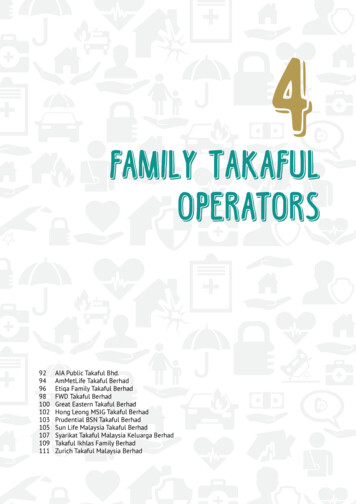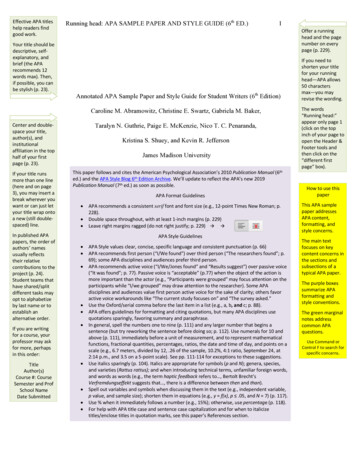
Transcription
Effective APA titleshelp readers findgood work.Your title should bedescriptive, selfexplanatory, andbrief (the APArecommends 12words max). Then,if possible, you canbe stylish (p. 23).Running head: APA SAMPLE PAPER AND STYLE GUIDE (6th ED.)1Offer a runninghead and the pagenumber on everypage (p. 229).Annotated APA Sample Paper and Style Guide for Student Writers (6th Edition)Caroline M. Abramowitz, Christine E. Swartz, Gabriela M. Baker,Center and doublespace your title,author(s), andinstitutionalaffiliation in the tophalf of your firstpage (p. 23).If your title runsmore than one line(here and on page3), you may insert abreak wherever youwant or can just letyour title wrap ontoa new (still doublespaced) line.In published APApapers, the order ofauthors’ namesusually reflectstheir relativecontributions to theproject (p. 24).Student teams thathave shared/splitdifferent tasks mayopt to alphabetizeby last name or toestablish analternative order.If you are writingfor a course, yourprofessor may askfor more, perhapsin this order:TitleAuthor(s)Course #: CourseSemester and ProfSchool NameDate SubmittedTaralyn N. Guthrie, Paige E. McKenzie, Nico T. C. Penaranda,Kristina S. Shuey, and Kevin R. JeffersonJames Madison UniversityThis paper follows and cites the American Psychological Association’s 2010 Publication Manual (6thed.) and the APA Style Blog 6th Edition Archive. We’ll update to reflect the APA’s new 2019Publication Manual (7th ed.) as soon as possible.APA Format Guidelines APA recommends a consistent serif font and font size (e.g., 12-point Times New Roman; p.228).Double space throughout, with at least 1-inch margins (p. 229)Leave right margins ragged (do not right justify; p. 229) à àAPA Style Guidelines APA Style values clear, concise, specific language and consistent punctuation (p. 66)APA recommends first person (“I/We found”) over third person (“The researchers found”; p.69); some APA disciplines and audiences prefer third person.APA recommends active voice (“I/We/Jones found” and “Results suggest”) over passive voice(“It was found”; p. 77). Passive voice is “acceptable” (p.77) when the object of the action ismore important than the actor (e.g., “Participants were grouped” may focus attention on theparticipants while “I/we grouped” may draw attention to the researcher). Some APAdisciplines and audiences value first person active voice for the sake of clarity; others favoractive voice workarounds like “The current study focuses on” and “The survey asked.”Use the Oxford/serial comma before the last item in a list (e.g., a, b, and c; p. 88).APA offers guidelines for formatting and citing quotations, but many APA disciplines usequotations sparingly, favoring summary and paraphrase.In general, spell the numbers one to nine (p. 111) and any larger number that begins asentence (but try reworking the sentence before doing so; p. 112). Use numerals for 10 andabove (p. 111), immediately before a unit of measurement, and to represent mathematicalfunctions, fractional quantities, percentages, ratios, the date and time of day, and points on ascale (e.g., 6.7 meters, divided by 12, .26 of the sample, 10.2%, 4:1 ratio, September 24, at2:14 p.m., and 3.5 on a 5-point scale). See pp. 111-114 for exceptions to these suggestions.Use italics sparingly (p. 104). Italics are appropriate for symbols (p and N); genera, species,and varieties (Rattus rattus); and when introducing technical terms, unfamiliar foreign words,and words as words (e.g., the term haptic feedback refers to , Bertolt Brecht’sVerfremdungseffekt suggests that , there is a difference between then and than).Spell out variables and symbols when discussing them in the text (e.g., independent variable,p value, and sample size); shorten them in equations (e.g., y f(x), p .05, and N 7) (p. 117).Use % when it immediately follows a number (e.g., 15%); otherwise, use percentage (p. 118).For help with APA title case and sentence case capitalization and for when to italicizetitles/enclose titles in quotation marks, see this paper’s References section.If you need toshorten your titlefor your runninghead—APA allows50 charactersmax—you mayrevise the wording.The words“Running head:”appear only page 1(click on the topinch of your page toopen the Header &Footer tools andthen click on the“different firstpage” box).How to use thispaperThis APA samplepaper addressesAPA content,formatting, andstyle concerns.The main textfocuses on keycontent concerns inthe sections andsubsections of atypical APA paper.The purple boxessummarize APAformatting andstyle conventions.The green marginalnotes addresscommon APAquestions.Use Command orControl F to search forspecific concerns.
APA SAMPLE PAPER AND STYLE GUIDE (6th ED.)Do not indent thefirst line of yourabstract.2AbstractMany APA papers submitted for academic courses and most APA papers submitted forpublication require an abstract. Often between 150 and 250 words, an abstract offers aCenter and do NOTboldface the wordAbstract at the topof a new page(usually page 2).concise, readable, objective one-paragraph summary to potential readers who areAbstracts should be“nonevaluative” (p.26). In other words,do not includeadjectives likecountless, unique,or breakthrough.scanning quickly through the first page(s) of a database search. An effective abstractintroduces the paper’s central concern or problem before offering a sentence or two oneach of the sections. For example, the abstract for an empirical paper might report thecontext (introduction/literature review), approach (method), findings (results), andimplications (discussion/conclusion). An abstract for a case study or stand-aloneliterature review might include similar features: why focusing on the concern or problemPublished APApapers ofteninclude key wordsto help readers findscholarship indexedin databases underspecific terms.If yourassignment asks forkey words, chooseterms thatsummarize whereyour paper fits inyour field of study.is useful, the characteristics of the participants or text(s) studied, analysis procedures,results/findings, and implications. Abstracts should be stand-alone documents: they mayPresent tense isappropriate in yourabstract as youintroduce yourpaper’s subject andas you survey itsapplications/implications. Pasttense is appropriateas you discuss themethods you usedand the outcomesyou measured (p.26).introduce key influences, theories, or measures but should not include in-text citations.Keywords: writing in the disciplines, APA sample paper, APA format and style,APA style guide, content area guidelines, sample APA references, undergraduateresearch and scholarshipFormat as shown:Indent and italicizeKeywords: andseparate words orphrases withcommas. Do notcapitalize the firstword (unless it is aproper noun), anddo not include afinal period. Manypapers offer just afew unalphabetizedkey words; if yourkey words run to asecond line, it goesflush left.
Center your fulltitle as shown (nobold) at the top of anew page.Use ( ) to introduceabbreviations andacronyms thatappear repeatedlylater in the paper.An abbreviationthat appears forthe first time in anin-text citationlooks like this:(AmericanPsychologicalAssociation [APA],2010).APA SAMPLE PAPER AND STYLE GUIDE (6th ED.)3Annotated APA Sample Paper and Style Guide for Student Writers (6th Edition)Indent the first lineof each newparagraph in thebody of your paper.The introductory section in an American Psychological Association (APA) Stylepaper establishes the purpose and problem that will be addressed. Where the abstract is aconcise summary, the introduction devotes more time to explaining the central concernor problem that the paper engages. The section typically situates the project within thefield by providing background information and relevant research or theories that theproject will use, build on, test, support, and/or add to. Early on, the section mightinclude one or more longer in-text citations featuring multiple key sources thatcontextualize the issue. The APA Style Blog 6th Edition Archive offers help withAPA Style valuesthe date thatsources werepublished. It shouldbe clear why youvalue older sources.Publication datesalways followimmediately afterauthors’ names.If you name theauthor(s) of a textin a sentence, itlooks like this:headings (Lee, 2011), tables and figures (Becker, 2016, 2019; Stefanie, 2009), andreferences (Lee, 2010, 2010). APA Style sample papers that follow 6th edition guidelinesare available online (APA, n.d.-a, n.d.-b; Purdue Online Writing Lab, n.d.-a).See the Referencessection for helpwith undated (n.d.)sources andsources by thesame author fromthe same year.Depending on the academic discipline and the type of paper, the introductionmight conclude with a hypothesis, a research or guiding question, a problem statement,or something closer to a traditional thesis (e.g., “Doing the work of this paperillustrates/reveals/ suggests/shows something new/important”). In addition to situatingthis purpose within the field and establishing the objective, the section often brieflydiscusses the research design and surveys the practical/theoretical implications of theeffort.Literature ReviewA Level 1 headingintroduces a newmain section in thepaper.If your paper includes a separate Literature Review or Background section, itfollows the introductory section. A literature review surveys the key scholarship that theCenter and boldLevel 1 headingsusing title casecapitalization.project will use, build on, test, support, and/or add to. The aim is to situate readersSee this paper’sReferences sectionfor help with titlecase capitalization.“professional” and “noncombative”: literature reviews should synthesize the themes,within the concern or problem that the rest of the paper will engage. The tone should befindings, and/or methods that past researchers have reported and should identifyLee (2011) notedthat X.If you havesummarized whatLee noted, no pagenumber isnecessary.See page 4 in thispaper for help withparaphrases andquotations.Alphabetizemultiple sources ina single in-textcitation by the firstauthors’ last names(i.e., by the first bitof information eachReferences entry).Separate eachsource in the ( )with a semicolon(as shown; p. 178).Exception: if youcite multiplesources by thesame author in asingle ( ), offer theauthor’s last nameonce, order thesources by year ofpublication, andseparate them withcommas (p. 178).
APA SAMPLE PAPER AND STYLE GUIDE (6th ED.)4opportunities for further research without stooping to exaggeration or personal attack(APA, 2010, p. 66). See Appendix B for help formatting in-text citations.Level 2 headingsintroduce newsubsections undera Level 1 heading.Bolded Level 2headings go flushleft on their ownline and use titlecase capitalization.APA style encourages writers to break sections into subsections to organize andlead readers through their thinking. Literature Review above is a Level 1 heading, andAPA papers often feature Level 2 headings (longer papers may include Level 3, Level 4,and even Level 5 headings, with each new level containing at least two subsections).Synthesizing SourcesPast tense orpresent perfecttense (“haveoffered”) isappropriate whendiscussing sourcesin literaturereviews (pp. 6566).A key aim in literature reviews is to synthesize sources, rather than to summarizethem one by one. Each section in a literature review typically engages multiple sourcesAs a general rule,reserve quotationsfor when the exactwording matters,and then helpreaders find yourquotations in theoriginal source.APA does not usen.p. to indicatethat there’s nopage number.If you cannot finda page number,use the paragraphnumber (e.g.,Smith, 2015, para.4). If the text doesnot number itsparagraphsbut includessection headings,use a short versionof the section titleand count theparagraphs (asshown).that focus on similar themes or report similar findings or use similar methods. Topicsentences in literature reviews are generally more about the paragraph’s largerconcern—the theme, finding, or method—than about what a single source says.Academic disciplines and courses have differing standards for what kinds ofsources are permissible. The APA (2010) Publication Manual focuses on journalarticles, but the deeper point is that writers should favor recent peer-reviewed primarysources (i.e., sources that present information gathered firsthand, instead of simplyreporting on someone else’s work; Lee, 2015). Writers should “evaluate each source onits own merits” to ensure that it is appropriate for inclusion (Lee, 2015, “ReliableAPA encourages—but does notrequire—thatwriters provide apage or paragraphnumber to helpreaders findparaphrases in theoriginal source,especially when thesource is long orcomplex (p. 171).Sources,” para. 1). APA Style is flexible enough to cite any source. Lee’s (2010) APAStyle Blog post offers guidance on citing website pages, YouTube videos, tweets,Instagram posts, and other online sources.Narrowing Down to a Research GapLiterature reviews generally narrow down to a research gap, a reason forconducting the current study. Is the work that the paper will do a next step in anevolving conversation, does it illuminate a promising gray area between disciplines, ordoes it apply existing approaches to an overlooked or emerging focus?If you want to end asentence with an(i.e.,) or an (e.g.,)and then need tocite one or moresources, use justone set of ( ),separating theconcerns with asemicolon, asshown.If the authorpossessessomething (e.g.,Lee’s post), includethe date after theauthor’s name, asshown.
APA SAMPLE PAPER AND STYLE GUIDE (6th ED.)5MethodThe Method section offers a detailed description of how the researcher conductedthe study. Different disciplines and kinds of papers feature different components indifferent orders, and researchers generally break Method sections into subsections. Theaim is to enable readers “to evaluate the appropriateness of your methods and thereliability and validity of your results” (APA, 2010, p. 29).Participant CharacteristicsIt is fine tointroduce a newlevel of heading andthen to moveimmediately into asubsection (asshown), providedyou have two ormore subsections.Animal participants. This subsection describes the sample’s demographicLevel 3 heading:indented, bolded,and capitalizedusing sentencecase capitalization.Include a boldedperiod after theheading and beginyour first sentenceas shown.Italicize Level 3headings to createLevel 4 headings:Search criteria.Remove the boldfrom Level 4heading to createLevel 5 headings:Search criteria.characteristics. If the study involved animals, report the genus, species, and strainnumber. Include the number of animals and their age, sex, weight, and condition.Human participants. This subsection describes the sample’s demographiccharacteristics (e.g., age, sex, education, group membership, status, and/or identity).Sampling ProceduresIf the study involved living human subjects, this subsection should detail howthey were selected, incentives for participating, the response rate, and any criteria thatdisqualified individuals from participating. This section should also affirm InstitutionalReview Board (IRB) approval where necessary, including the assigned IRB protocolnumber. If the study focused on texts—i.e., a literature review—this section might betitled Search Criteria. It might establish the scope of the review by identifying databasesor journals searched and key terms and dates used to limit the search (Kay, 2015).MeasuresThis Method subsection identifies instruments used to measure, collect, andsafeguard data. If the study involved surveys, questionnaires, interviews, orobservations, it describes their design and affirms their internal and external validity.Broadly speaking, internal validity requires that measures be appropriate (e.g., they havebeen used before, or tested/vetted) and that they are administered fairly/consistently.Past tense isappropriate in theMethod section.Present perfecttense (e.g.,“Researchers haveused the measuresince 1995”) is alsoappropriate (p. 66).
APA SAMPLE PAPER AND STYLE GUIDE (6th ED.)6External validity refers to how generalizable any results can be. Do the measures permitthese results to be compared to other results? Will the measures produce results andallow conclusions that can apply to other settings, groups of people, or times?Research DesignThis Method subsection describes the technical aspects of the research processand is often a step-by-step procedural. For instance, when was the intervention—theexperiment, survey, or observation—administered, by whom (with what training), forhow long, in what kind of setting, to whom, with what controls in place to ensurereplicability/validity? The subsection may also be labeled Procedure, and may includeLevel 3 and even Level 4 headings.Data AnalysisSome APA papers include a Data Analysis subsection that describes the orderand types of analysis (e.g., statistical tests, coding) used to interpret the raw quantitativeand/or qualitative data.Past tense isappropriate indescribing anempirical researchstudy that hasalready beenconducted.Research proposalsoften feature aData Analysis Planthat specifies howdata will beanalyzed. Futuretense is appropriatein this instance.ResultsSometimes titled Data or Findings, the Results section summarizes the pertinent resultsidentified through the analysis. Researchers should present all results that bear on thehypothesis/ research question/problem statement, including results that contradict thehypothesis. Bem (2003) suggests that an effective Results sections offers a narrative:“You cannot just throw numbers at readers and expect them to retain them in memoryuntil they reach the discussion” (p. 9). Bem suggests beginning the section by remindingreaders of the questions/hypothesis the paper engages and the operations performed/behaviors measured. Results sections are often divided into subsections: each Resultssubsection might end with a summary that makes sense of the subsection’s data, andeach new Results subsection might begin with a clear transition that leads smoothly intothe next step in the narrative (Bem, 2003).Past tense (e.g.,“Participantsreported that ” or“The percentagedecreased from ”)is appropriate inthe Results section(p. 66).
APA SAMPLE PAPER AND STYLE GUIDE (6th ED.)7TablesResults sections often refer to tables that summarize quantitative or qualitativefindings that cannot be expressed simply or clearly in the text of the paper (Becker,2019). The APA (2010) suggests that “Tables should be integral to the text but shouldbe designed so that they can be understood in isolation” (p. 128). The text should referto every table but should discuss only the highlights (see Table 1). Tables requiremultiple rows and/or columns; they are not simply bullet-pointed lists (Becker, 2019).Table 1Some disciplinesintegrate tablesand figures intothe main text;others relegatethem to anappendix orappendices.Some disciplinesask that each tableand figure be on aseparate page, nomatter where itappears in thepaper.Some disciplinesask that tables,table notes, andfigure captionsretain the samedouble-spaced 12point Times NewRoman font usedelsewhere in thepaper. Otherspermit singlespacing andsmaller fonts forthe sake ofreadability.For more on APAtables and figures,exact formatting,and a table thatspans more thanone page), see theAppendix sectionat the end of thispaper.APA Style Guidelines for Tables and FiguresFormatRetain standard font and (wherepossible) standard font size; singlespacing within tables is fine; favorwhite space over ruled linesFigures(graphs, charts, maps, images)May use a sans serif font, bolding,and different font sizes; label allaxes; figures should be large/clearenough to be read easilyPlacement intextDepends on the disciplinary field,guidelines, and audienceDepends on the disciplinary field,guidelines, and audienceConcernTablesMentioned in Required: “As shown in Table 1” ortext(see Table 1)Required: “As shown in Figure 1”or (see Figure 1)Titles andcaptionsTitle: above the table, doublespaced, in title case, and italicized;brief, clear, self-explanatory (seeTable 1)Caption: below the figure, insentence case and not italicized;brief, clear, self-explanatory (seeFigure 1)NotesA note (optional) below the tableexplains any points of emphasis,abbreviations of technical terms,or sourcesAfter the caption title, include anyexplanatory information: points ofemphasis, abbreviations, orsourcesSourcesTables that present information notcreated by the researcher requirecitations.a Tables adapted orreproduced from other sources mayrequire permission from thecopyright holderbFigures that present informationnot created by the researcherrequire citations. Figures adaptedor reproduced from other sourcesmay require permission from thecopyright holderNote. Table notes are formatted as shown. Use a general note like this one to explain information relating tothe table as a whole and/or offer a credit line acknowledging a source for the table as a whole. This note usesa smaller font size to ensure that the whole table fits on a single page for the sake of readability.aSpecific notes refer to an individual row, column, or cell. If individual rows in a table are drawn from aspecific study or other source, you may use normal ( ) within the table, usually in the first column. Becker(2016) offers help in using superscript (e.g., a and b in the last row above) to cite sources within tables. bLee(2016a) and Figure C1 of this paper offer help in formatting credit lines below tables and figures.Tables and figures(and/or referencesto them) are notrestricted to theResults section(e.g., a sourcematrix in aliterature review).
APA SAMPLE PAPER AND STYLE GUIDE (6th ED.)8FiguresFigures—graphs, maps, charts (e.g., flow charts or schematic diagrams), andimages—can help the reader visualize the researcher’s findings (see Figure 1).Refer to eachfigure in the maintext, just as yourefer to each tablein the main text.If you put figuresand tables inappendices, yourreference maylook like this: (seeAppendix A) or(see Figure C1).See this paper’sAppendix sectionfor more help.Figure formatting. The APA (n.d.-b; 2010) suggests that each table and figurein manuscripts submitted for publication should be included on a separate page after theReferences section and that explanatorynotes and captions be double-spaced in12-point font. Some disciplines oraudiences ask that tables and figures beincluded near where they are referenced inthe text, in which case they may bepositioned differently on the page, andnotes and captions may be single-spacedin a smaller font for the sake of clarity).Figure 1. Detail from case scenario programpage. Adapted from “Tutor Training GoesDigital,” by M. Chandler, 2017 opyright 2017 by Maya Chandler. Used withpermission.Figure citations. Like tables, figures that present information not created by theresearcher require citations. While information presented in tables is cited using APA intext citations or superscript (see Becker, 2016), sources for figures require fullercitations, as shown in the captions for Figures 1 and 2. See Lee (2016a) for formattingguidelines and note that figure sources are also included in the References section.Images and CopyrightTables and figures reproduced from other sources count as images. Do notsimply scan, download, or snip images for use in your own work, even if someone elsehas already (legally or illegally) reproduced the images. In addition to requiring citations,they may require permission from the copyright holder (Lee, 2016a, 2016b).Fair use law may give academic researchers some legal cover for infringing onartists’ copyright, but it is best not to trespass too frequently on this legal gray area.The first bit ofinformation in yourfigure caption,formatted insentence case, isyour figure title. Donot include a titleabove the figureand do not embeda title within thefigure.
APA SAMPLE PAPER AND STYLE GUIDE (6th ED.)9Wherever possible, use images in the public domain or that have been licensed throughCreative Commons, or write directly to the copyright holder for permission.Discussion and ConclusionSome disciplines and writing tasks may call for splitting the Results, Discussion,and Conclusion into three separate sections. Others may require or allow the researcherto combine the results and discussion into a single “Results and Discussion” section,particularly when the discussion is brief and clear. A third approach separates Resultsand Discussion into two sections, treating the Conclusion as a final subsection in theDiscussion.DiscussionThe Discussion section focuses on the immediate, internal interpretation andevaluation of results, particularly as the results inform the paper’s central hypothesis orresearch question. How and how well do the results support the hypothesis or answer theresearch question? If they don’t support the hypothesis or answer the research question,why don’t they? Why do you think you got the results you did? How do the resultscompare to results achieved in other comparable studies?Limitations in design or execution. The Discussion section often includes aLimitations subsection that objectively assesses the quality of the results. Despite thetraditional “Limitations” title for the subsection, the aim here is not to systematicallyundermine everything that has come earlier. Rather, the aim is to qualify the results,where a qualifier is a limitation or modification of meaning. In an immediate sense,whether or not the results support the hypothesis or answer the research question, arethere any concerns about their internal validity? For instance, did the research processexpose biases, weaknesses, or imprecision in the method or its execution?Limitations in generalizability. More broadly, how externally valid are theresults? Will these results be replicable in or applicable to other settings or in othersituations?
APA SAMPLE PAPER AND STYLE GUIDE (6th ED.)10ConclusionBuilding on the earlier discussion, including the strengths or weaknesseshighlighted in the Limitations subsection, the Conclusion comments on “the theoretical,clinical, or practical significance” of the study as a whole (APA, 2010, p. 36). Againstthe initial problem or question that motivated the study, what do the findings mean forthe particular discipline or field within the discipline? What do they suggest or allow?What directions for future research are now advisable or possible? What new horizonsor questions are now visible? Without overstating the importance of the effort, what areits broader implications or applications? Why should audiences within and beyond theparticular discipline value and build on the study?
New page,centered, no bold.APA SAMPLE PAPER AND STYLE GUIDE (6th ED.)11ReferencesAmerican Psychological Association (n.d.-a). Figure 2.1 [Sample paper]. Retrieved fromDouble-spacewithin andbetween eachreference. Indentsecond andsubsequent linesin each sample-experiment-paper-1.pdfAmerican Psychological Association (n.d.-b). Figure 2.2 [Sample paper]. Retrievedfrom ple-experimentpaper-2.pdfAmerican Psychological Association (n.d.-c). Quick answers—Formatting. RetrievedSample bookreference.from attingAmerican Psychological Association. (2010). Publication manual of the AmericanPsychological Association (6th ed.). Washington, D.C.: American PsychologicalAssociation.Becker, D. (2016, June 22). Navigating copyright: How to cite sources in a table [BlogInclude theMonth and dayfor preciselydated sources(e.g., social mediaposts andcomments,newspapers,weeklymagazines).Where no date isavailable, use(n.d.).Use brackets afterthe title todescribe theformat ofnonstandard texts(e.g., blog posts,art, videos,lecture notes).Referencessections shouldinclude sourcesthat you mentionor cite ( ) at leastonce in your maintext.post]. Retrieved from cker, D. (2019, March 4). What qualifies as a table or figure in APA Style? [Blogpost]. Retrieved from erences GuidelinesThis paper’s References section offers examples of common citations. For help formatting APA intext citations, see the Literature Review section and Figure B2 in this paper’s Appendix. For helpformatting citations within tables, see Table 1 and the Table 1 Note. For help formatting figureand table credit lines, see Figure 1 and the box next to Figure 1.References entries include four key pieces of information: Author (date). Title. Publicationinformation.Authors Most references start with an author or team of authors. List all authors (up to seven) inthe order they appear in the text with last names followed by initials; separate eachauthor with a comma; include an & before the final author’s name (e.g., Abramowitz, C.M., & Swartz, C. E.). For eight or more authors, list the first six and the last, using a . . .before the last author’s name (e.g., Penaranda, N. T. C., . . . Jefferson, K. R.). If no individuals are identified, references may start with the name of the publishingorganization, association, corporation, or government department. If no author or publishing group is available even after tracing back through the URL andsearching elsewhere online, start the reference with the title.Alphabetize entriesby the first word ineach reference,ignoring the wordsA, An, and The.Numbers arealphabetized by theway they arespelled (e.g., Figure2.1 comes beforeFigure 2.2 becausethe o in one comesbefore the t intwo).In APA Stylealphabetizing,“nothing precedessomething,” whichmeans that a textby Jones, A. B.(2018) wouldprecede a text byJones, A. B., &Smit
Annotated APA Sample Paper and Style Guide for Student Writers (6th Edition) e introductory sectionin anAmerican Psychological Association (APA) Style paper establishes the purpose and problem that will be addressed. Where the abstract is a concise summary, the introduction devotes more time to explaining the central concern

